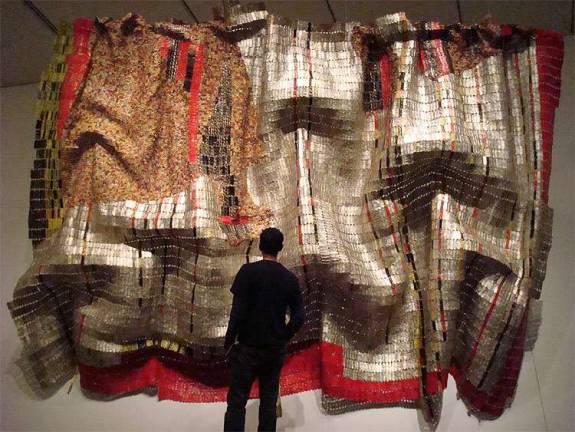Creative Capstone

The monumental El Anatsui exhibition at the Brooklyn
The fifth floor rotunda of the Brooklyn Museum is used to great effect as the entrance to "Gravity and Grace: The Monumental Works of El Anatsui," a memorable exhibition of works by El Anatsui. The Ghanian-born artist has taught and worked in Nsukka, Nigeria since 1975, when he was about 30 years old, and in the past decade or so has gained international renown with his immense fabric-like constructions made from bottle caps.
His breakthrough to contemporary art stardom came when he was featured in the 2007 Venice Biennale. Anatsui's works are now in major museum collections; fine examples are on display at MOMA and the Met. This is his first solo show in a New York museum. Being in the presence of so many wondrous pieces at once is magical-a different order of magnitude than experiencing them individually.
Excellent videos in which the artist discusses his life and his work provide information and context without intruding on direct engagement with the objects. They are excerpts from films by art historian Susan Mullin Vogel, whose informative book on the artist is available for consultation in the gallery and on sale in the museum shop.
Throughout his career, Anatsui has used handicraft techniques and worked with local, found materials to make art from discarded objects that have outlived their original purpose. He likes materials that already embody a history, and his approach is in keeping with African traditions of spiritual transformation. Plentiful, inexpensive materials free him to experiment without size limitations.
Anatsui had worked masterfully in a number of traditional media before he turned to metal detritus. While not a full-fledged retrospective, the exhibition includes various precursors to the bottle-cap series: free-standing wood sculptures; scrap wood wall reliefs; sculptures that resemble gigantic papier-maché grocery sacks, constructed of thin metal printers' plates discarded by a local newspaper; and gleaming flexible sculptures made of lids from cans of powdered milk. Anatsui sends his work out into the world to be arranged and displayed to suit the occasion and the site. Since the metal pieces can be stretched, crimped and draped, they take on different appearances in each venue.
How the bottle cap series began: There are several distilleries in Nsukka. While the liquor bottles are reused, the aluminum caps are melted down. One auspicious day, Anatsui came across a bag filled with colorful bottle caps, which he took to his studio, sensing they might find some way into his work. Fiddling around, he separated some circular tops bearing the brand logo from the tubular collars, which were printed in color on the outside and bare metallic silver or gold on the inside; cut open and flattened the tubes into strips, and began arranging the uniformly sized pieces into a pattern. He made holes near the edges and joined pieces with twists of copper wire. Voilà, he had created a segment of malleable metal fabric. Thus began more than ten years of creative ferment.
Once he realized that this mode of work was more than a brief experiment, Anatsui arranged to purchase his bottle cap supplies, and organized studio assistants to assemble blocks of metal fabric that can be laid out on the floor and manipulated into complex designs under his direction, likening his method of pushing color around to the way that painters compose. He then photographs the initial design, uploads the images to a computer, and employs cutting-edge technology to refine the composition and archive his studies. It takes 20 or more people three or more months to assemble a large hanging.
The color palette is determined by the decoration of the caps. Mostly red, black, yellow and white, they are printed with decorative patterns and logos that add variety. (I counted some 50 different brands represented in just one gallery of the exhibit.)
He has invented more than a dozen different shapes and configurations of flattened, folded, crushed, and twisted tops and collars, and lately fashioned incredible mesh-like curtains from the rings that remain on the neck of the bottle after the cap has been twisted open.
The exhibition opens in a large, bright space segmented by immense examples of those mesh curtains suspended from the very high ceiling at varying angles. You cannot help but engage with them both imaginatively and physically. Are you on a stage set, in a foreign country, or perhaps in a waking dream? The installation invites you to move around among the hangings, and approaching one for a close-up view, you discover that the entire piece is constructed of coin-size rings of colored metal joined together with bits of twisted copper wire. What beckons you as soft and pliable is actually sharp and dangerous, just one of many dichotomies inherent in Anatsui's work.
The centerpiece of the exhibition is a baronial hall where stupendous, vari-colored, mostly opaque hangings are arrayed on the walls. Of course, association with African kente cloth is inevitable. Many other possibilities also come to mind. Are these tapestries in a medieval court; an homage to Italo-Byzantine mosaics; princely robes; opulent fabrics for turn-of-the-century Viennese fashionistas; theater curtains; or contemporary paintings? You can have a wonderful time playing make-believe in their presence. At the same time, the centuries-long cross-cultural exchange among Africa, Europe and the Americas is a powerful underlying theme of the liquor bottle-cap series, counterbalancing their surface glamour.
The exhibition invites return visits and has remained on view long enough to accommodate them. If you haven't been yet, go now before it's too late!
"Gravity and Grace: The Monumental Works of El Anatsui" at the Brooklyn Museum through August 18.